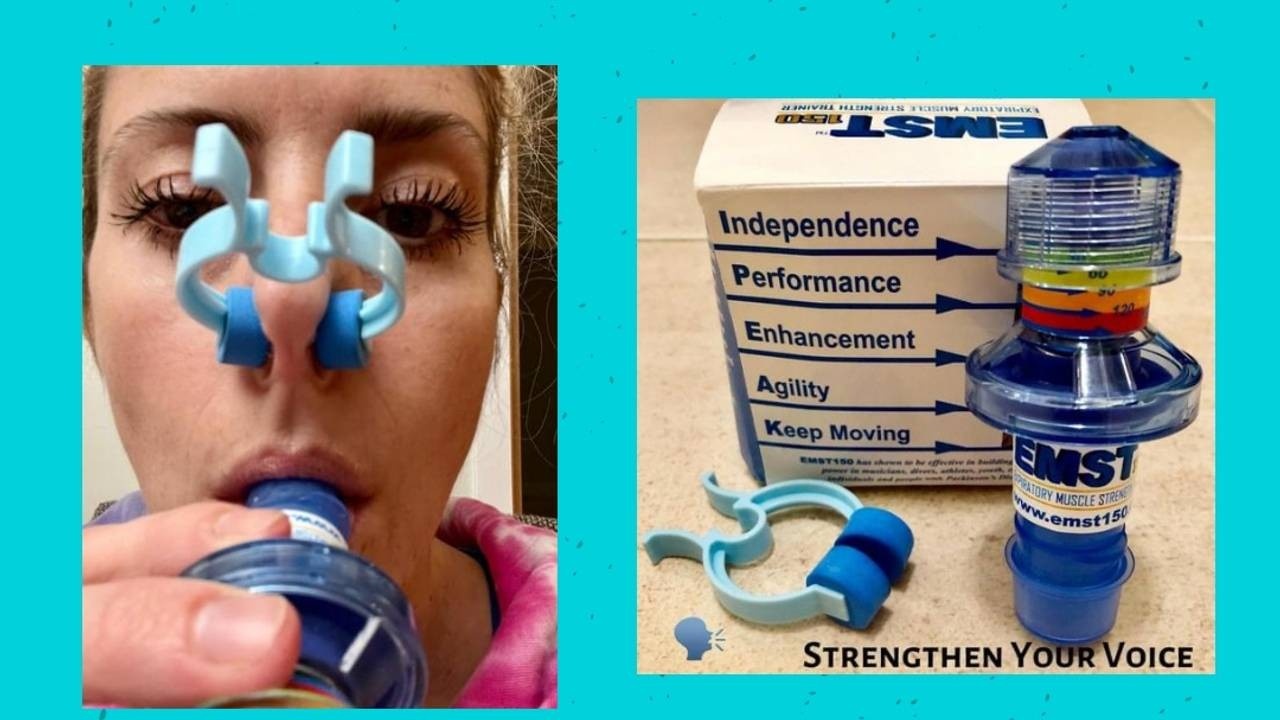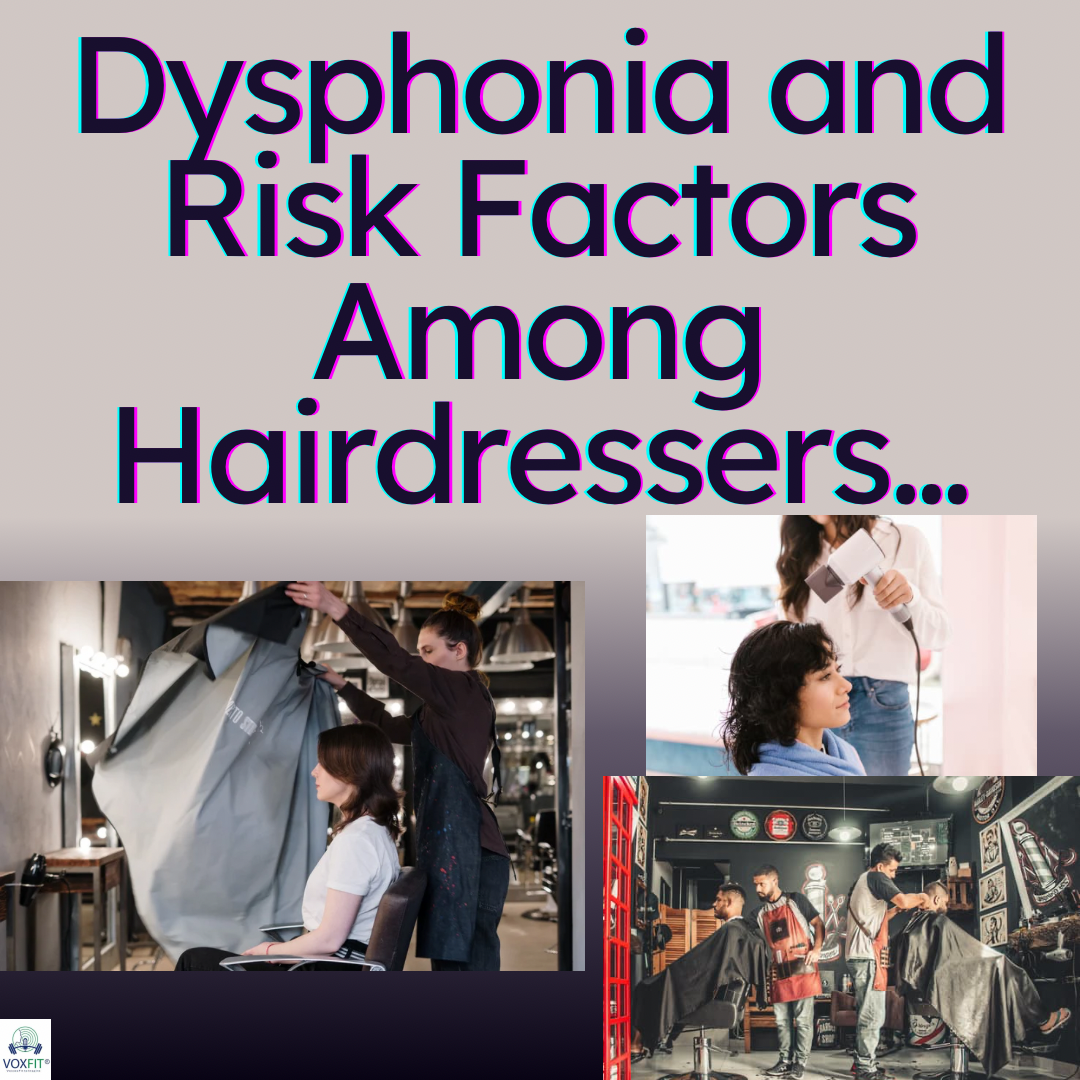Dysphonia Among Hairdressers, EMST-150 Revisited, and PYV!

Dysphonia and Risk Factors Among Hairdressers...
YOUR HAIRDRESSER. You see them once every few months (or more or less), and they’ve become your friend. They’ve been with you through the highs and lows…they’re great listeners and great conversation partners. BUT do you even realize they are at high-risk for voice disorders? A new (2022) study by Kasbi et al. looked into exactly that!
.
Hairdressers work in a variety of body postures, are required to stand for prolonged periods of time, experience consistent mechanical pressure on the joints, deal with irregular mealtimes and improper (or absent) rest periods during work time, and work in the presence of significant ambient noise. Additionally, hairdressers are constantly exposed to hazards including excessive use of shampoos, emulsions, creams, hair dyes, bleaches, hair sprays, cleaners, and chemicals. Previous studies have identified a high prevalence of respiratory disease among these occupational voice users, with symptoms including asthma, chronic bronchitis, rhinitis, cough, and phlegm (and all of these can increase the risk of developing dysphonia). AND HAIRDRESSERS ARE CONSTANTLY TALKING (and often doing so over ever-present BACKGROUND NOISE like hair dryers, music, other conversations, etc.).
.
The study sought to identify the self-reported prevalence of voice symptoms in hairdressers and found that this prevalence was HIGHER for the hairdresser group (33.33%) than for the control (non-hairdresser) group (15.75%). Hairdressers experienced MORE significant HOARSENESS, VOCAL FATIGUE, LARYNGEAL DRYNESS, and COUGH than the control group. Interestingly, studies conducted in several countries worldwide (Italy, Iran, Greece, Nigeria) have shown hairdressers are prone to RESPIRATORY SYMPTOMS due to work conditions, and also suggest that they are AT-RISK for voice problems involving mucosal changes. The present (2022) study findings also revealed that the presence of PHONOTRAUMATIC BEHAVIORS in hairdressers and INCREASING WORK HOURS PER WEEK are often accompanied by an increased risk of dysphonia.
.
As this population of occupational voice users is at high-risk of voice problems, it is recommended they receive vocal hygiene education and possibly additional voice training aimed towards PREVENTING dysphonia.
.
.
#themoreyouknow #voxfit #hairdresser #occupationalvoiceuser #vocalhealth #vocalhygiene #voicecoaching #voicetherapy #voicedisorders #voice #vocalefficiency #vocalfolds #vocaleffort #strain #hoarseness #dysphonia #hair #hairsalon #hairstylist #research #prioritizeyourvoice #prevention #educationispower
EMST-150 -- How Can it Help You?

I’ve gotten a ton of questions about EMST-150 lately, so I figured I’d do a repeat post all about it (and why I love it so much!). The Expiratory Muscle Strength Trainer (EMST-150) is a calibrated device that offers individuals the ability to train muscles specific to their activities and track progress over time by focusing on improving maximal expiratory pressure along with the strength and activation of the abdominal and expiratory muscles. It is the most scientifically tested and clinically proven handheld expiratory muscle strength trainer available. The 5-week training program (with a recommended post-training maintenance program) has been proven to improve cough strength, general force production and endurance of breathing, respiratory strength overall, VOICE, and subglottic air pressure (associated with improvement of coordination and accuracy of swallowing function which reduces risk of airway compromise). The device has been proven to help those with voice and/or swallowing disorders, airway disorders, AND THOSE WHO ARE CONSIDERED “NORMAL” (singers, musicians, clergy, athletes, fitpros, public speakers, etc.). The EMST-150 is one of my all-time favorites for patients, clients, and vocally “normal” people too (including myself!). I completed the 5-week program awhile back and then did the maintenance program for a few YEARS. It’s super easy to do and I notice the benefits. I actually restarted it last week just because I felt like a recharge for vocal and respiratory strength. I always prioritize exercising my body (and mind), but specifically focusing on EXERCISING THE MUSCLES OF EXPIRATION is a great choice for #voice.
.
It is a known fact in the worlds of exercise physiology, physical therapy, and/or personal training that the best way to improve strength is to add resistance to a movement pattern and continue practice of that pattern with the higher resistance level, while maintaining good “form” and achievement of the exercise goal, despite the increased resistance. No pressure, no diamonds, right? In addition, after repeating this level of resistance for several days, the goal is to continue the exercise, but increase resistance again as long as the goal can still be accomplished (with accuracy, form, alignment, etc.); in this way the target muscle group will consistently be strengthened versus become familiar with or habituated to a certain resistance level (which results in no overall increase in strength but only a possible maintenance of tone). So, if you are feeling a tad stagnant, weak, or even “under-stimulated”, the best course of action is to ADD RESISTANCE. Just like in our life journey, when we add resistance (in whatever capacity)—although at times nerve-wracking or stressful—we ADD COURAGE and we always GROW from this change, finding STRENGTH along the way (which benefits our whole self—physical body, mind, and spirit).
.
WHY target the muscles of EXPIRATION? It is fairly common knowledge that as we age, we lose strength in skeletal muscles—these muscles include our respiratory muscles too! We know that strength training of our muscles is very effective for increasing muscle mass (as previously mentioned), and we need to apply these same principles to our respiratory muscles, as these muscles are responsible for strength of cough, voice, and swallowing.
.
Research studies on the EMST-150 device have shown benefit in several populations including those with ALS, cervical or spine injury, COPD, head/neck cancer, multiple sclerosis, Parkinson’s Disease, stroke, obstructive sleep apnea, snoring, shortness of breath, cough dysfunction, irritable larynx, dysphonia, dysphagia, and healthy active seniors. In addition, additional studies have shown benefit in athletes, vocalists, professional voice users, and wind instrument musicians.
.
Research has shown that professional SINGERS/PERFORMERS who trained with the device demonstrated a significant increase in maximum expiratory pressure/strength (MEP) with an average 84% increase by the end of the treatment phase. These vocal athletes also displayed significantly longer durations for singing as well as decreased breathlessness. ATHLETES who trained with the EMST-150 experienced “significantly increased MEP (which is a direct contributor to endurance and is essential for athletes who are engaged in high-breath endurance sports). Muscle strength training with the EMST-150 can improve expiratory muscle strength, endurance, and overall sports performance”. Key benefits for professional voice users include: improved sound quality, volume, range, and MEP, as well as enhanced voice recovery, reduced VHI-10 scores, significantly longer singing duration with decreased breathlessness, and improved voice capabilities in as little as 2-3 weeks.
.
To increase strength, we must TRAIN and we must ADD RESISTANCE. Specific to OCCUPATIONAL and PROFESSIONAL VOICE USERS, a GOAL should be to STRENGTHEN the muscles that support vocal production—the expiratory muscles. Check out the EMST-150 device for a portable, lightweight, strength-training tool aimed to improve and support your vocal instrument.
.
.
#voxfit #voicefitness #fitness #vocalfitness #vocalstrength #respiratorystrength #strength #emst150 #strengthtrain #voicesfittoinspire #yourbestvoicenow #voiceshine #speak #publicspeaking #fitpro #voicespecialist #voicecoaching #speechpathology #speechpathologist #voicetherapy #blaise #occupationalvoiceuser #strengthenyourvoice #exercise #resistance #trainyourvoice
Anddd of course, always REMEMBER to PRIORITIZE YOUR VOICE!
How are YOU prioritizing your voice today? And everyday? As an OCCUPATIONAL VOICE USER, it should be one of your top priorities!
.
.
What do you need to know to keep your voice healthy? You should understand how the voice works, how to protect and care for your voice, and how to use your voice and entire vocal mechanism in the most efficient, effective, and dynamic ways possible.
.
.
I’m super PASSIONATE about this population of voice users (I’m one and most of you are too!), and am HERE TO HELP! Reach out with any questions, concerns, or if you’d like to work together. Email me at [email protected]
.
.
.
.
#voxfit #desiretoinspire #aspiretoinspire #changelives #radiateconfidence #vocalinstrument #voice #voicefitness #vocalfitness #voicesfittoinspire #vocalathlete #occupationalvoiceuser #speechpathology #voicespecialist #teacher #instructor #fitnessinstructor #singer #performer #emcee #gamehost #clergy #sales #coach #speechpathologist #voicetherapy #voicedisorders #prioritizeyourvoice


